 Credit: Michael Simon/IDG
Credit: Michael Simon/IDG
When comparing phones, you generally want them to be in the same league. These days that might mean there’s a few hundred dollars separating the models—like the iPhone 11 and iPhone 11 Pro, or the Galaxy S20+ and the OnePlus 8 Pro—but everyone knows the $1,400 Galaxy S20 Ultra will trounce a $400 Galaxy A51.
But Apple’s new iPhone SE is a horse of a different color. Yes, it’s Apple’s budget phone and costs more than a thousand dollars less than the highest-end Galaxy S20, but it also has a bunch of Apple’s latest tech. And, you know, it’s an iPhone.
I did the unthinkable and compared it to the three of the top Android phones available today: Galaxy S20 Ultra ($1,400), Google Pixel 4 ($900) and OnePlus 7T ($600). Add it all up and you’ve got $3,000 in Android phones against one lowly $399 iPhone. But what should have been a ridiculously one-sided battle was surprisingly close.
iPhone SE vs Android: Design
The iPhone SE looks and feels like an older phone. Like the iPhone 8, the SE is extremely similar to the hardware introduced with the iPhone 6 in 2014 and you can feel every bit of its six-year-old design. The screen is small, the bezels are monstrous, and the home button is physical. It’s been a long time since an Android phone of any repute had a home button, and the SE looks and feels downright antiquated in comparison to the other phones here.
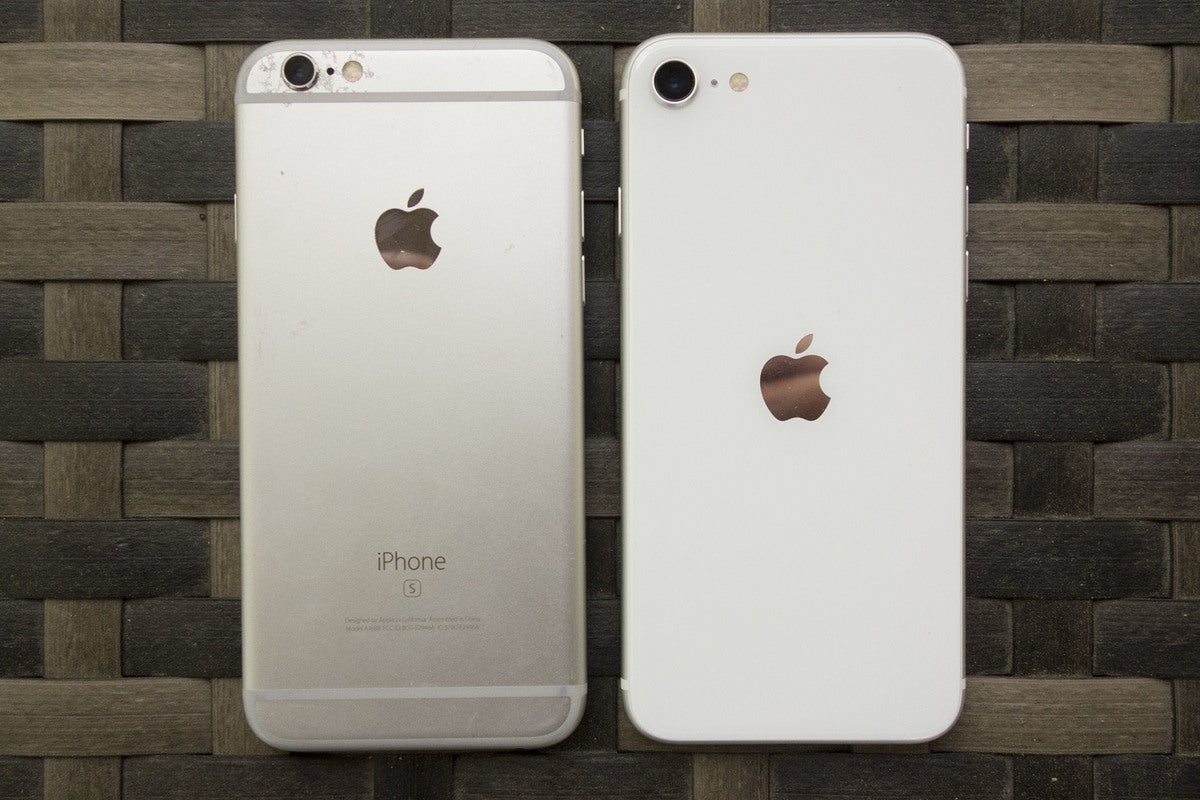 Michael Simon/IDG
Michael Simon/IDG
The iPhone SE (right) has extremely similar dimensions to the iPhone 6s.
I’m not going to debate the designs of the other phones, but I will say this: Despite its ancient looks, the iPhone SE is an extremely attractive phone with a solid build quality and retro charm. Even Apple’s old designs are better than some of today’s Android phones, and the glass back, aluminum sides, and carefully curved chamfers are satisfyingly symmetrical and ergonomically pleasant. The S20 and 7T are definitely a step ahead in the looks department—the Pixel 4 is a toss-up—but for a phone that hasn’t been in style for years, the SE really isn’t so bad.
Granted, its not a phone for everyone, but those who like or can get past its outdated Home button will appreciate is craftsmanship. The smooth glass back and polished aluminum edges bely its $399 price tag, and the whole package feels like a premium handset. Its bezels are way too big to compete with the other phones here, but there’s a certain charm to the iPhone SE—and it’s nice not to have to worry about palm rejection. There’s also something to be said for a phone that fits in any pocket.
iPhone SE vs Android: Display
Right off the bat, the iPhone SE is at a disadvantage. While the Android phones here all have high-refresh-rate OLED displays, the iPhone SE uses an LCD screen that pales in comparison to the other phones here:
Galaxy S20 Ultra: 6.9-inch Quad HD+ Dynamic AMOLED, 120Hz, 3200x1440, 511 ppi
Pixel 4 XL: 6.3-inch Quad HD+ P-OLED, 90Hz, 3040x1440, 537ppi
OnePlus 7T: 6.55-inch Full HD+ AMOLED, 90Hz, 2400x1080, 402ppi
iPhone SE: 4.7-inch HD IPS LCD, 60Hz, 1334x750, 326 ppi
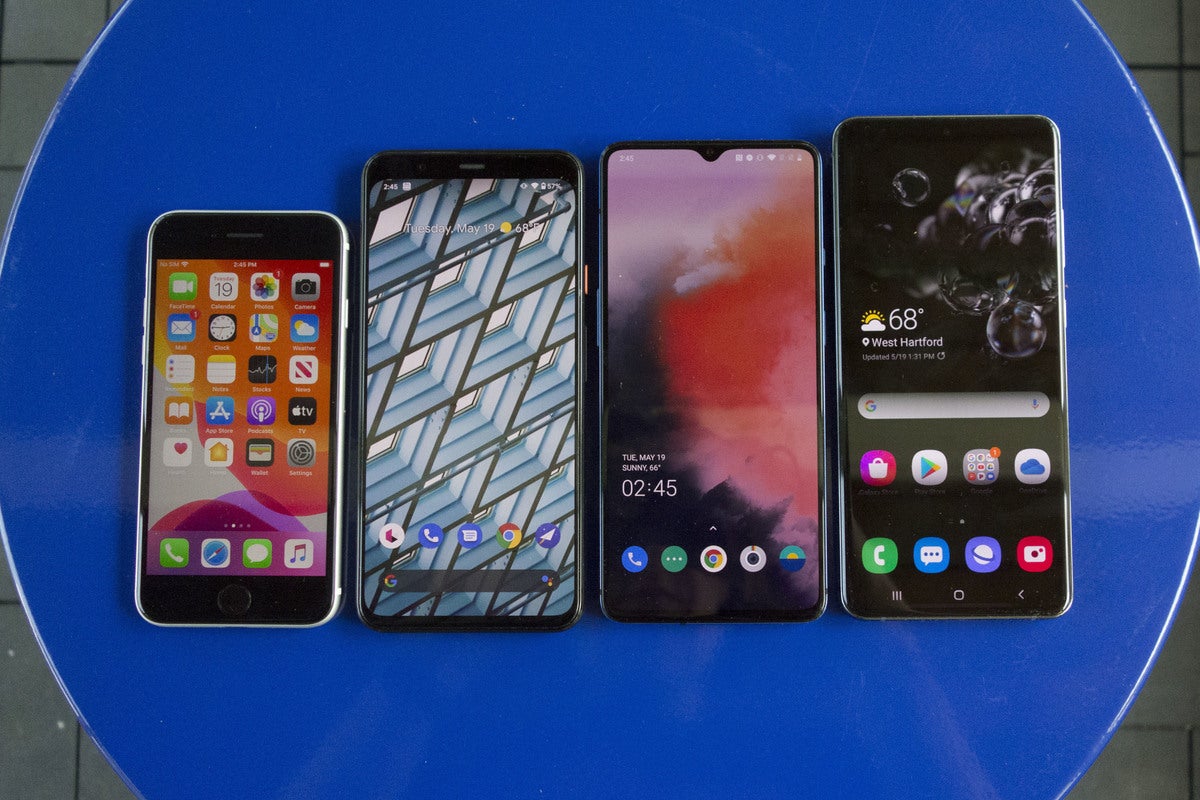 Michael Simon/IDG
Michael Simon/IDG
There’s a 2.2-inch difference between the iPhone SE’s screen and the Galaxy S20 Ultra’s.
Apple labels the iPhone SE a Retina HD display rather than Liquid Retina, but it’s essentially the same display as the iPhone 11 with square corners instead of rounded ones. But for an LCD that’s already several years old, the iPhone SE’s screen is surprisingly good. Text is crisp and it’s very bright, rivaling the peak manual brightness I was able to achieve on the other displays using the same all-white image.
Galaxy S20 Ultra: 610 nits
Pixel 4 XL: 745 nits
OnePlus 7T: 870 nits
iPhone SE: 740 nits
However, with adaptive brightness turned on and a direct source of bright light applied, the results were dramatically different.
Galaxy S20 Ultra: 1275 nits
Pixel 4 XL: 1075 nits
OnePlus 7T: 1275 nits
iPhone SE: 840 nits
With adaptive brightness turned on, the OLED displays can leverage advanced algorithms and higher contrast ratio to deliver fuller colors and impressive brightness. And they’re far superior on the lower end too, with incredibly deep blacks that put the SE’s LCS to shame.
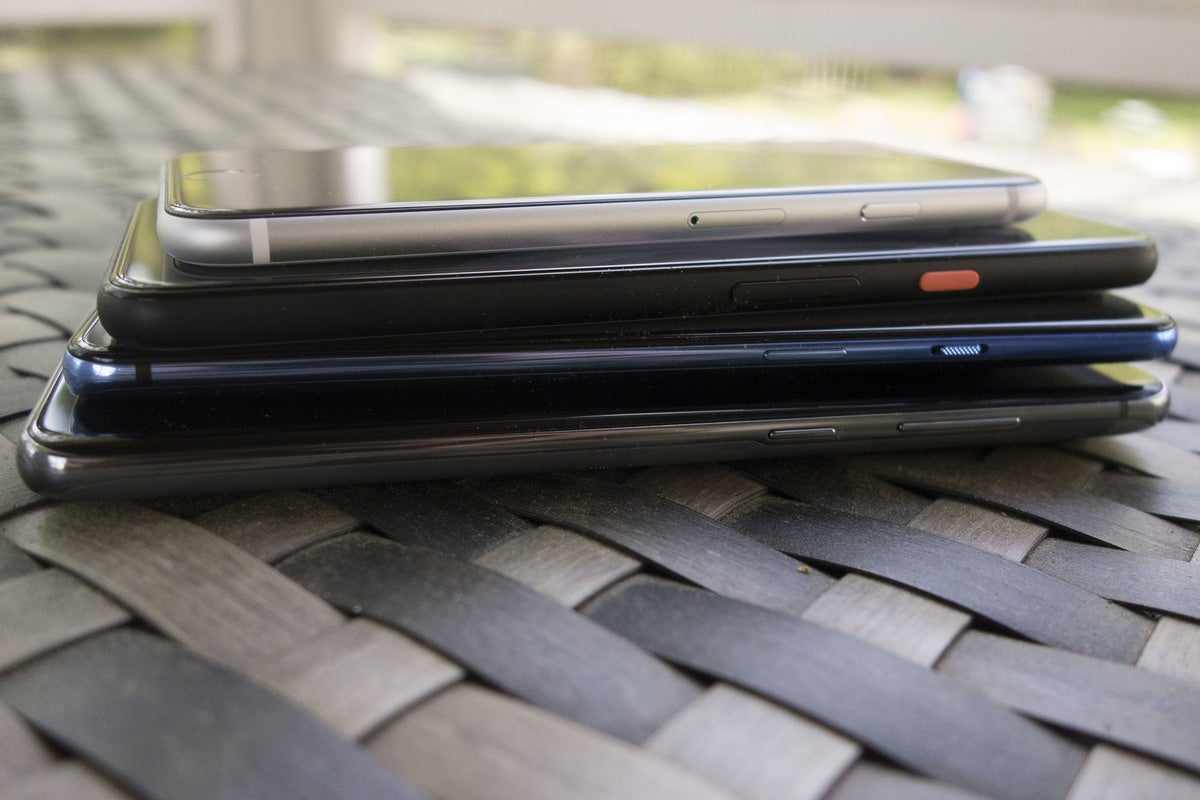 Michael Simon/IDG
Michael Simon/IDG
The iPhone is the thinnest phone here but not by much.
Then there’s the issue of size. The iPhone SE isn’t just small for 2020, it looks comically small compared to the Galaxy S20 Ultra and is more than an inch and a half smaller than the average Android flagship. Even the 5.8-inch screen on the iPhone 11 Pro looks monstrous by comparison, and videos and websites feel very cramped by comparison. With Apple rumored to be switching to an all-OLED lineup for the iPhone 12, the SE’s LCD is going to quickly become obsolete, but all in all it’s a decent display.
iPhone SE vs Android: Performance
Quite frankly, the iPhone SE wouldn’t be worth its salt (or comparing to the phones here) if not for its processor. Apple has put the iPhone 11 Pro’s A13 processor inside the iPhone SE, making it one of the speediest phones ever made and certainly the fastest for less than $400.
I picked the three phones I did because they represent the cream of Qualcomm’s Snapdragon crop. The S20 Ultra uses the 865, the best system-on-chip available, the OnePlus 7T is powered by the Snapdragon 855+, and the Pixel 4 runs the Snapdragon 855. Simply put, you won’t find a trio of faster processors in any Android phone. But pitted against the lowly iPhone SE, the three phones simply can’t stack up:
Geekbench 5 (CPU)
Galaxy S20 Ultra
Single-core: 901
Multi-core: 3245
Pixel 4 XL
Single-core: 724
Multi-core: 2529
OnePlus 7T
Single-core: 772
Multi-core: 2883
iPhone SE
Single-core: 1331
Multi-core: 3310
Before you ask, those results are with all of the latest patches and updates installed and following fresh restarts. I performed them multiple times and took the best results. In short, there’s no contest. The iPhone SE not only handles the best Android phones, it handily beats phones costing twice and thrice as much. And when it comes to graphics, the iPhone SE is a beast.
Geekbench 5 (Compute)
Galaxy S20 Ultra: 3085
Pixel 4 XL: 2149
OnePlus 7T: 2675
iPhone SE: 6413
That’s not to say any of the phones here are slow. Far from it. The Galaxy S20 Ultra and OnePlus 7T both have UFS 3.0 storage along with 12GB and 8GB of RAM, respectively, compared to the iPhone SE’s 3GB. The Pixel 4, like the iPhone SE, has the benefit of being engineered alongside the same team that makes the Android operating system. But even with those advantages, the iPhone SE is basically faster in every way.
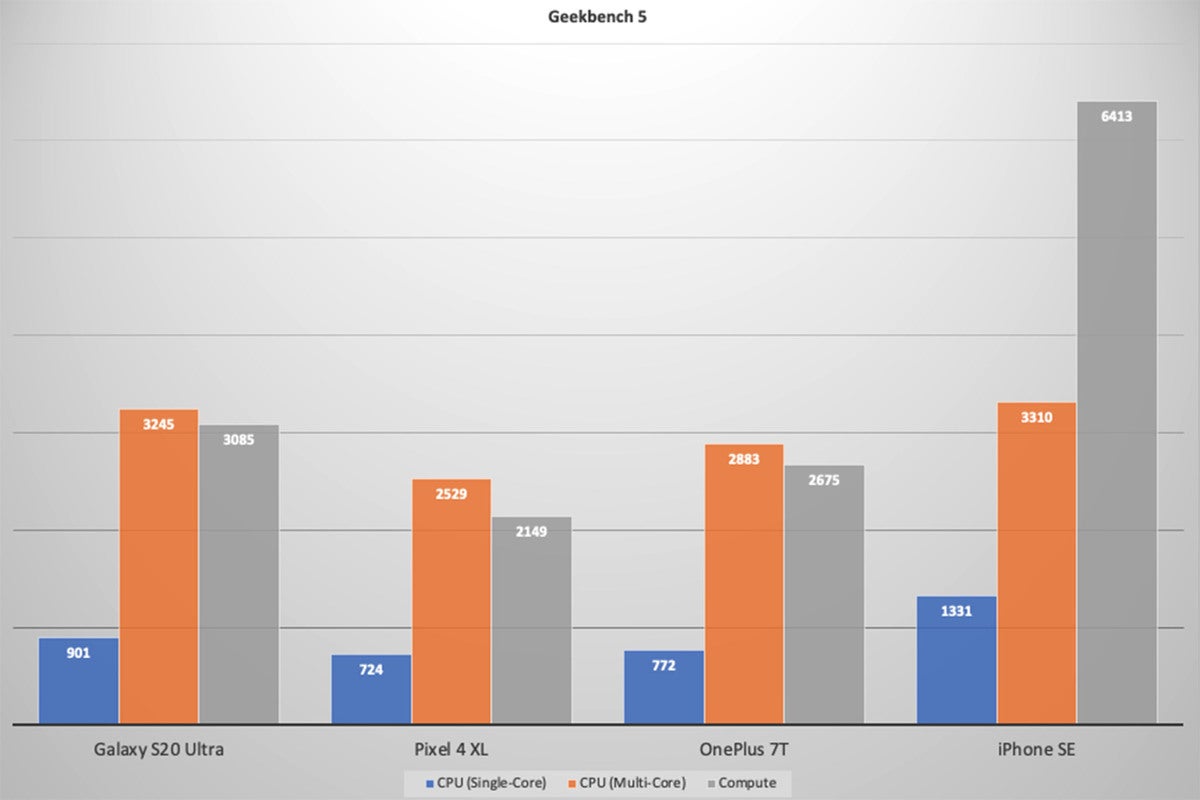 IDG
IDG
The iPhone SE simply trounced the best Android phones when it comes to processing speeds and graphics power.
And if you were to compare the iPhone SE to a $399 Android phone, the results would be lopsided to the point of being absurb. Don’t believe me? Take a look at the Geekbench 5 scores for the Pixel 3a, which is widely regarded as the best budget Android phone you can buy:
Single-core: 351
Multi-core: 1244
Compute: 639
And those are good numbers compared to the Exynos-powered Galaxy phones in that price range. But honestly, even if the upcoming Pixel 4a were to share the same Snapdragon 855 processor as the Pixel 4, the iPhone SE would still run circles around it.
iPhone SE vs Android: Battery and charging
Granted, the Android phones I looked at are much bigger, so they will have bigger batteries. Apple doesn’t divulge the battery capacity of its phones, but through teardowns it’s been revealed that it has the same 1,821mAh battery as the iPhone 8. By any metric that’s incredibly small, but it’s downright puny compares to the others here.
Galaxy S20 Ultra: 5,000mAh
Pixel 4 XL: 3,700mAh
OnePlus 7T: 3,800mAh
It’s also small compared to Apple’s other offerings. The iPhone XR has a 2,942 mAh battery, the iPhone 11 has a 3,110 mAh battery, the iPhone 11 Pro has a 3,046 mAh battery, and the iPhone 11 Pro Max has a 3,969 mAh battery. And in this case, size definitely matters. The iPhone SE’s battery life is acceptable in that it’ll probably get most people through a day of normal use, but it’s not going to blow anyone away. And if you plan on using it do to a good amount of streaming or navigation, you’re going to want to have a charger nearby.
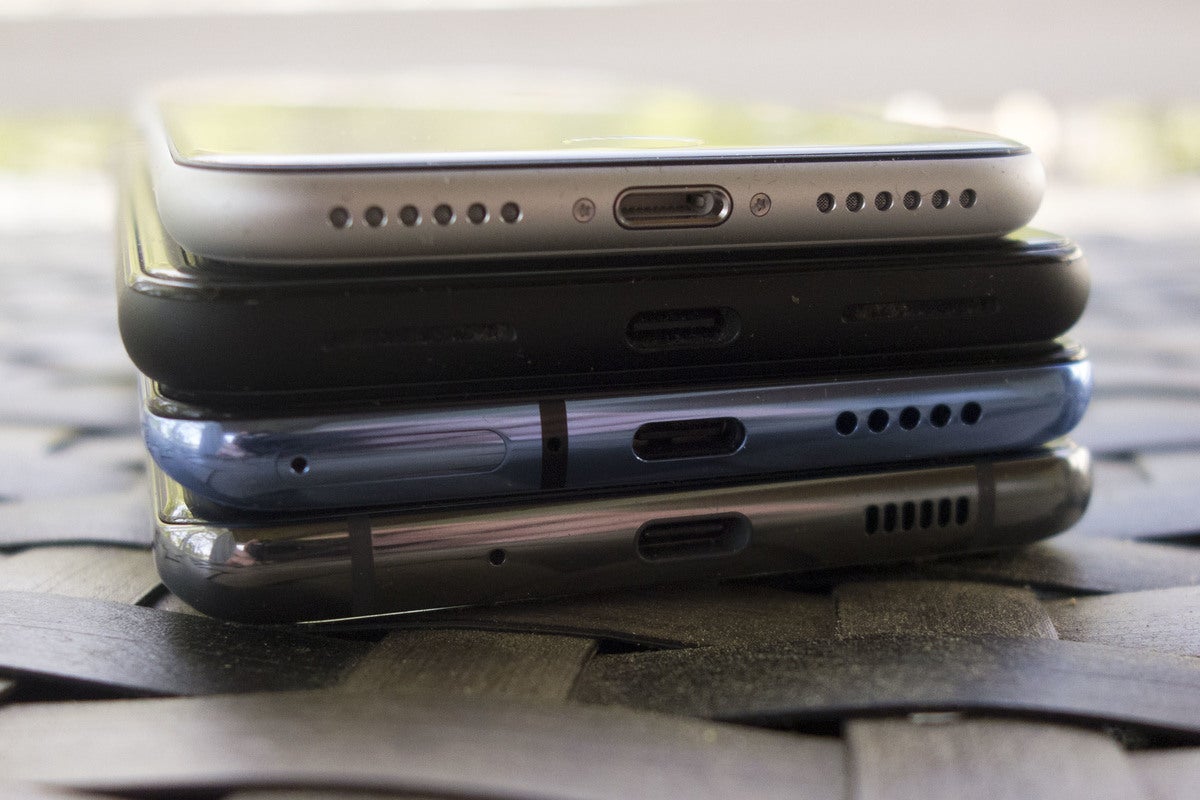 Michael Simon/IDG
Michael Simon/IDG
If you’re going to be using the iPhone SE’s Lightning port for charging, you’ll want to invest in a better adapter.
In my testing, I played a two-hour movie on the brightest settings with automatic brightness turned on and then the same movie with automatic brightness turned on. Here’s how much battery life each phone used:
Galaxy S20 Ultra: 23 percent
Pixel 4 XL: 35 percent
OnePlus 7T: 29 percent
iPhone SE: 46 percent
Even with far fewer pixels to push, you’ll need to fil the SE up far more often than the other phones here. When that time arrives, iPhone SE supports wireless charging, which is something of a rarity for a phone this cheap. (Case in point: The OnePlus 7T and the newer OnePlus 8 do not.) Charging speeds are acceptable but the SE is still the slowest of this bunch, topping out at 7.5W, half what the Galaxy S20 offers (15W) and slower than the Pixel 4’s 11W max speeds.
For wired charging, the iPhone SE comes with a lame 5W adapter in the box, which will take a painfully long two-plus hours to fully charge your iPhone SE. That’s fine if you’re plugging it in before bedtime, but if you’re looking for a quick charge before heading out for the night, you’re going to want to plan ahead.
All of the other phones support fast-charging out of the box and they each destroy the SE’s charging speeds. The OnePlus 7T can reach 30W, the S20 hits 25W, and the Pixel 4 gets 18W. The difference between them is pretty minimal, with all them filling up between 40 to 50 percent of the battery in a half hour, but they shine a harsh light on Apple’s stubborn refusal to give up the 5W charger, which also comes with the iPhone 11.
The good news is that the iPhone SE does support 18W fast charging, but you’ll need to buy a charger capable of 18-watt speeds and a USB-C-to-Lightning cable. You can buy both at Apple.com for $48 but you’re better off checking Amazon for a high-rated third-party option.
iPhone SE vs Android: Biometrics
The iPhone SE is the only phone here (and really, anywhere) to use a physical fingerprint scanner. I don’t think Apple is capable of making a $399 iPhone with Face ID, so until the next iteration of the SE, this is a fine tradeoff. The Pixel 4 uses 3D face unlock and it’s nearly as fast as it is on the iPhone 11. It’s slightly less convenient than a fingerprint sensor in that you need to be looking directly at your phone, but it’s more secure.
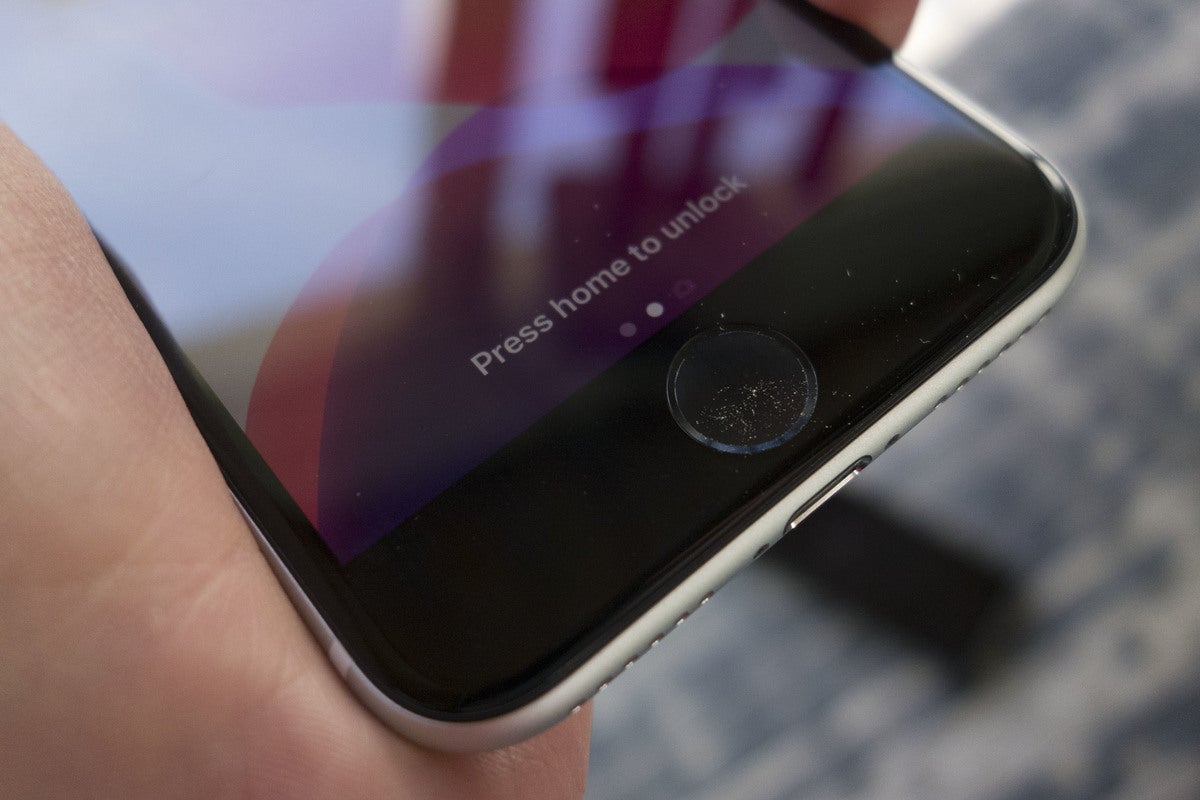 Michael Simon/IDG
Michael Simon/IDG
Yup, that’s an honest-to-goodness home button.
Even budget phones have begun to adopt in-display fingerprint scanners like the Galaxy S20 Ultra and the OnePlus 7T, so the technology should be mature by now. But while in-display scanners look good and enable near-edge-to-edge designs, they’re not nearly as fast as physical fingerprint scanners. My iPhone SE unlocked in a split-second every time I attempted it while the two phones with in-display sensors sometimes struggled. As an admittedly unscientific test, I set a stopwatch for a minute and timed how many times I could lock and unlock each phone with he same finger:
Galaxy S20 Ultra: 29
Pixel 4 XL: 33
OnePlus 7T: 28
iPhone SE: 42
Apple’s Touch ID sensor might not be as cool or pretty as an in-display scanner, but physical scanners are simply superior to virtual ones. You can find it without looking, you don’t have to wait for the screen to turn on, and they’re more reliable. The iPhone SE’s physical scanner might not be pretty, but it’s still the speediest way to implement biometric unlocking on a phone.
iPhone SE vs Android: OS updates
The merits of iOS versus Android will be debated forever, so I’ll leave that argument for another day, But one thing is clear: You’ll still be getting updates to your iPhone SE in 2024. And you’ll probably be able to install iOS 18 on it too. That Galaxy S20 Ultra people are spending $1,400 on is lucky to get Android 12 in two years.
 Michael Simon/IDG
Michael Simon/IDG
The iPhone SE will still be getting updates long after the S20 is EOL’d.
There’s no contest here. I’ll admit that Android phone makers have gotten way better at pushing updates in a timely fashion and communicating to customers what they’re going to be getting, but even the best Android phone in the iPhone SE’s price range, the Pixel 3a, only guarantees two years of version updates and three years of monthly security updates. And Samsung’s low-cost offerings only get quarterly updates.
iPhone SE vs Android: Camera
The newest iPhone is always at or near the top of the smartphone heap when it comes to taking pictures, but the SE is a new iPhone in name only. That’s not to say it has a bad camera, but it’s far cry from the multi-camera modules in the iPhone 11 Pro and the Android phones here. You’re getting a capable camera, but I don’t think we’ll be seeing any iPhone SE pics in Apple’s next Shot on iPhone campaign.
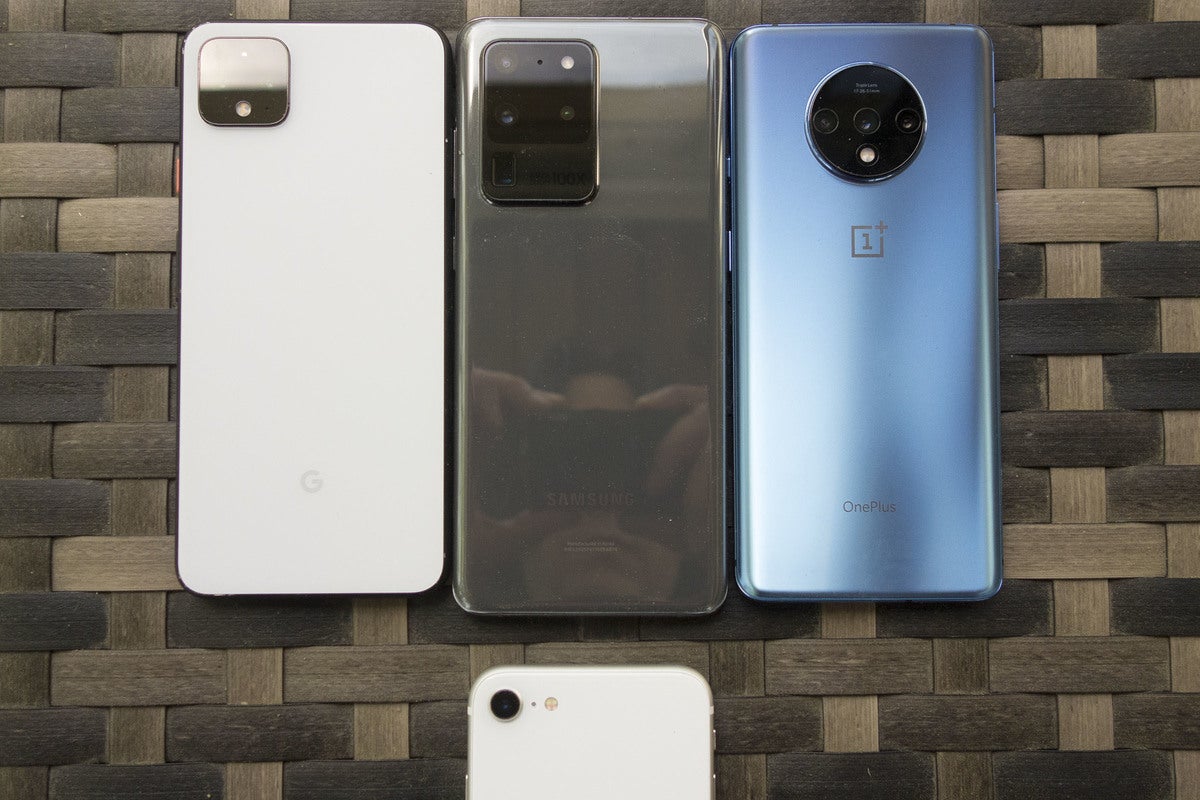 Michael Simon/IDG
Michael Simon/IDG
Can one camera take on nine?
The biggest gap between the iPhone SE and the other phones here is with low-light photos. Apple made a big deal of Night Mode on the iPhone 11, and rightfully so—the iPhone 11’s algorithms do a remarkable job of extending the capture time and amping up the exposure to reduce noise and up the brightness in challenging light.
Without Night Mode, the SE struggles like Apple’s phones used to, and the results are dark and grainy. They’re passable in most cases, but compared to the phones here, especially the Pixel 4 XL, there’s no contest. Night Mode is the main thing I miss with the SE, and it’s frustrating that Apple left it out, since the camera and chip seem to be technically capable of handling it.
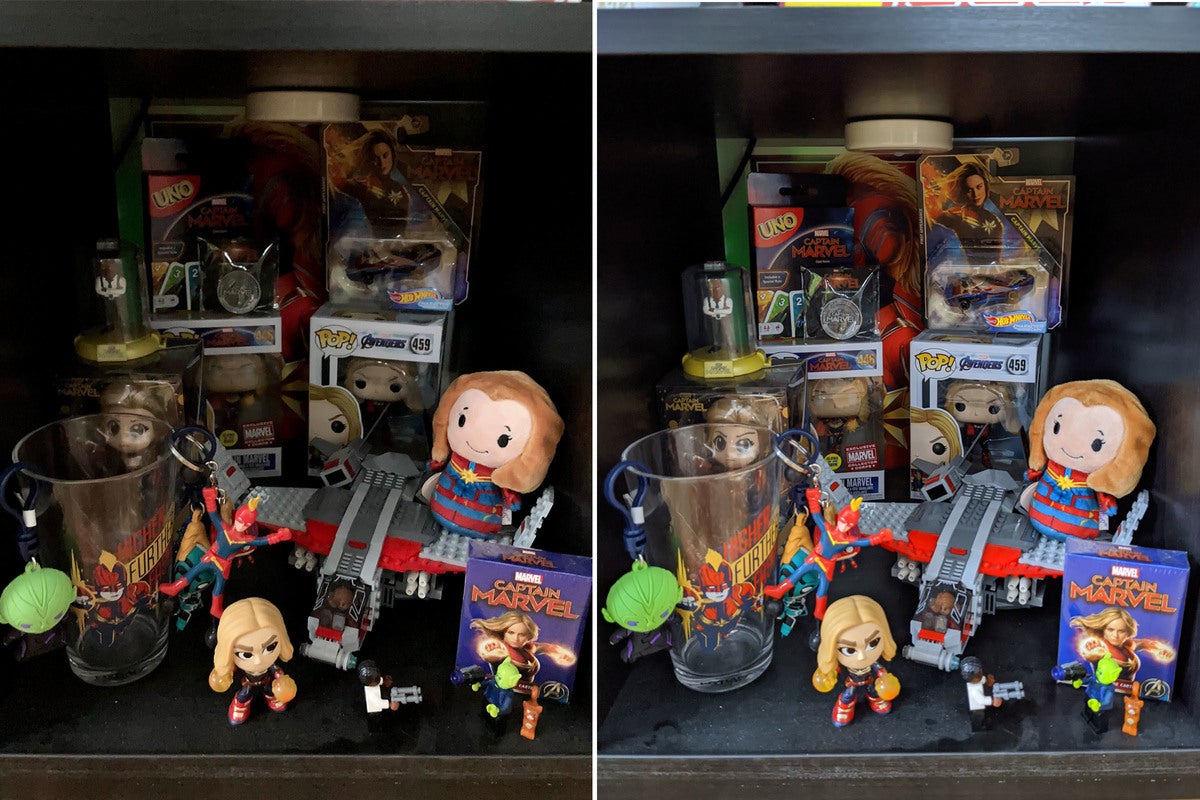 Michael Simon/IDG
Michael Simon/IDG
When the light goes down, the iPhone SE’s deficiencies come out.
Even with a single lens, the iPhone SE can take portraits, but like the iPhone XR, it only works with people. It’s another weird limitation that other single-camera budget phones don’t have, but the SE takes fantastic bokeh shots of humans. Even compared to the S20 Ultra, which has four cameras including a dedicated depth sensor, the iPhone SE performed impressively. In the photos below, the iPhone SE handled the bright background without a hitch and even did a better job with my son’s skin tones, particularly his rosy cheeks.
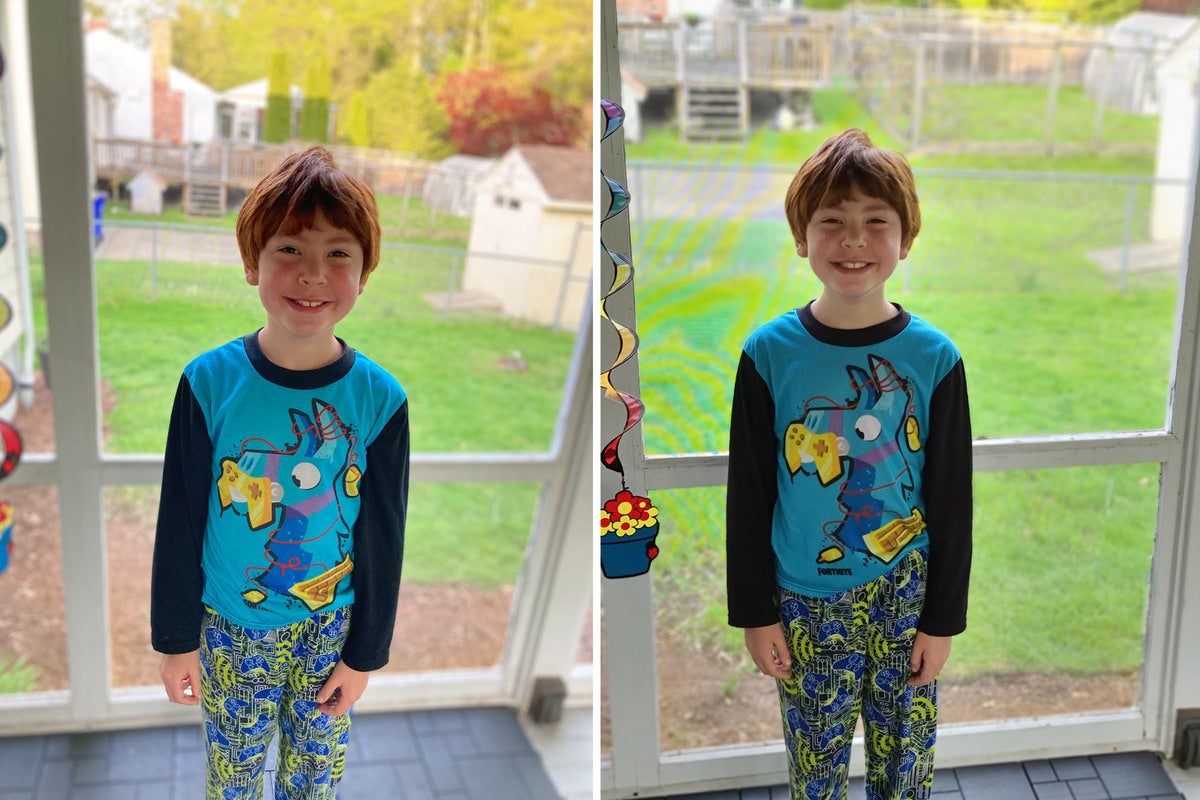 Michael Simon/IDG
Michael Simon/IDG
The iPhone SE (left) is as good of a portrait taker as the S20 Ultra even with a single camera.
The iPhone has always had a tendency to tamp down the color in photos in favor of real-world accuracy, and the iPhone SE doesn’t stray from that lane. In the photo below, the OnePlus 7T oversaturated the green a bit and added a cool tint to the wall while the SE maintained color accuracy and proper white balance.
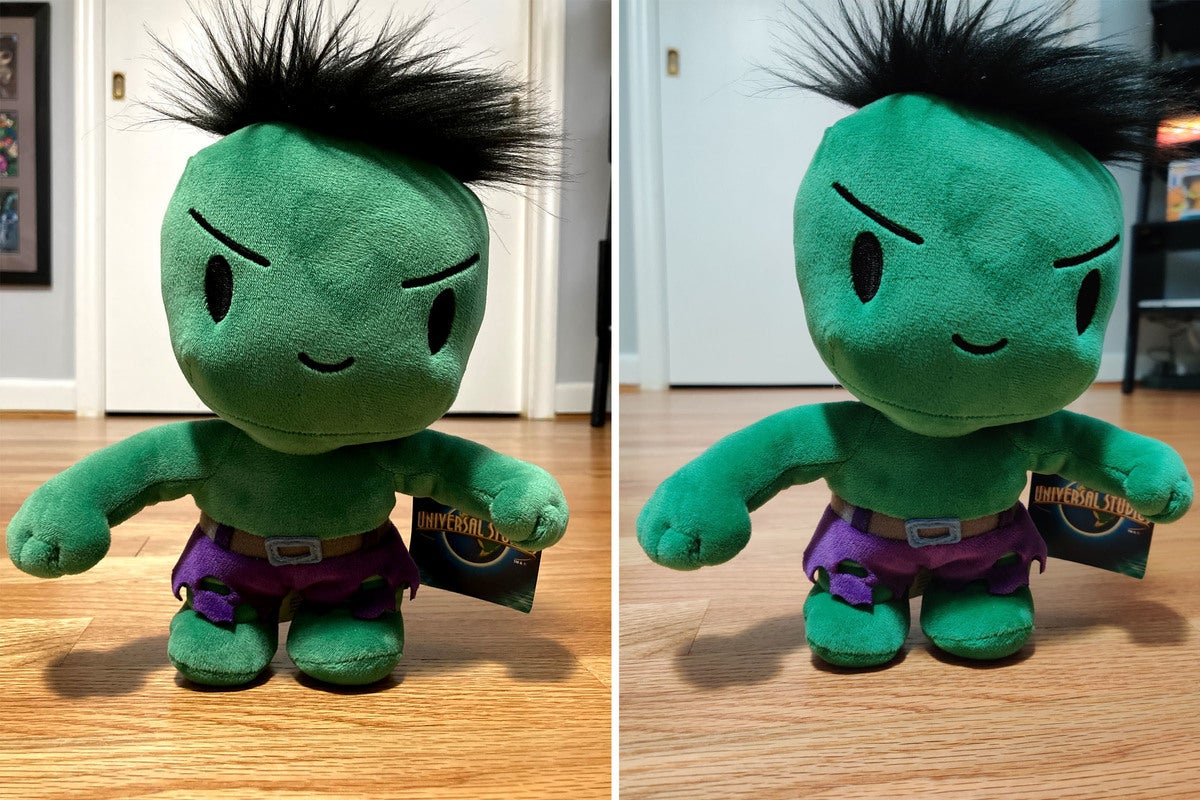 Michael Simon/IDG
Michael Simon/IDG
The iPhone SE (left) did a better job than the OnePlus 7T with handling the color in this shot.
The results see somewhat subjective, but the SE does its best to properly capture the scene. And in the right light, it’s as good of a point-and-shoot as the other cameras here.
iPhone SE vs Android: Conclusion
I can’t imagine anyone with a thousand bucks to spend on a new smartphone would actually opt for an iPhone SE over the iPhone 11 Pro or one of the Android phones here, but if they do, they’ll be getting a phone that’s faster, more pocketable, and plenty capable of taking very good pictures. More importantly, if you’re on a budget, it’s an extremely attractive option no matter which platform flag you fly under.
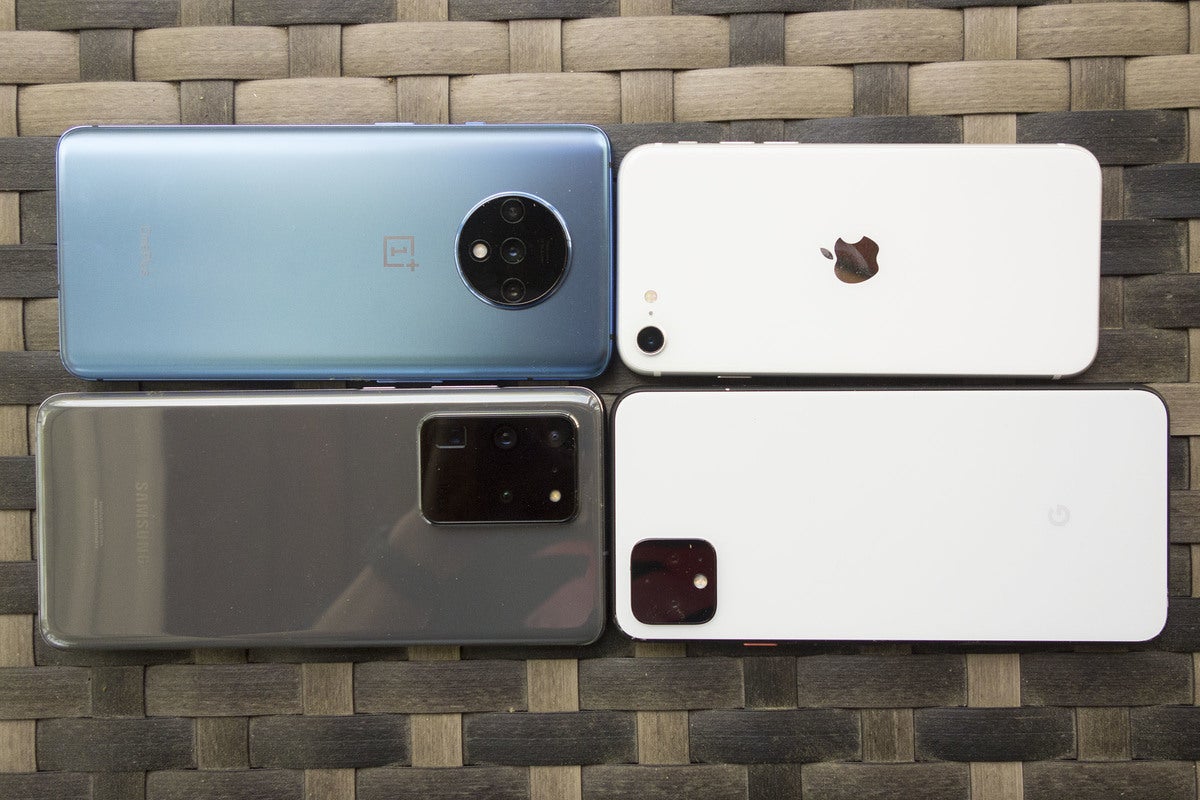 Michael Simon/IDG
Michael Simon/IDG
The iPhone SE costs hundreds less than the OnePlus 7T, Galaxy S20 Ultra, and Pixel 4 XL.
The speed of the iPhone SE is simply mind-blowing. With the same design as my old iPhone 6s, I expect it to be pokey, but the SE flies through tasks and apps with ease. I didn’t expect it to stack up to the other phones here in every category, but its tremendous performance is eye-opening and compensates for some of the areas where it falls a little short, namely the display and battery.
In short, the compromises Apple made with the SE are smart. Yes, it’s an old design and lacks some of the newest iPhone tech, but it’s a $399 phone that won’t feel sluggish after a year or two or four, which is more than you can say for any Android price in that price range—and even a few that are much more expensive.

















